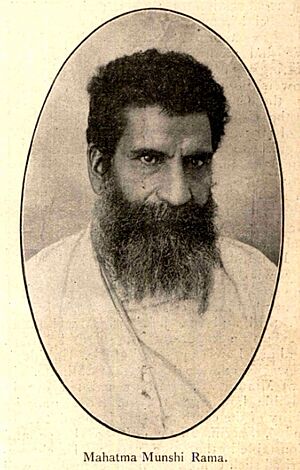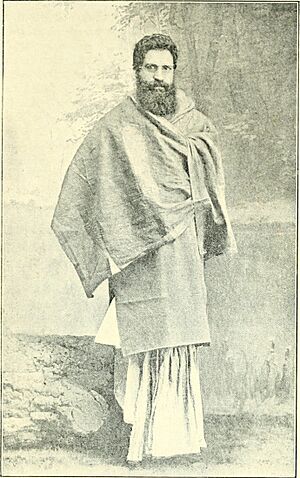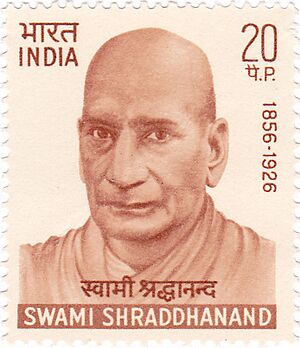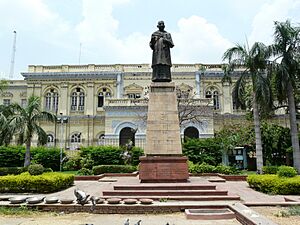Swami Shraddhanand facts for kids
Quick facts for kids
Swami
Shraddhanand
|
|
|---|---|
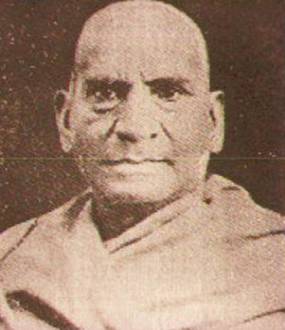 |
|
| Born | 22 February 1856 Talwan, Jalandhar, Punjab, India
|
| Died | 23 December 1926 (aged 70) Delhi, India
|
| Cause of death | Assassination |
| Known for | Social worker Freedom Fighter Independence Activist Teacher Religious Leader |
Swami Shraddhanand (born February 22, 1856 – died December 23, 1926) was an important leader in India. He was also known as Mahatma Munshi Ram Vij. He was a spiritual teacher and a brave fighter for India's freedom from British rule.
Swami Shraddhanand followed the teachings of Dayananda Saraswati. He helped start schools like Gurukul Kangri University. He also played a big part in movements to unite and reform the Hindu community in the 1920s.
Contents
Early Life and Education
Swami Shraddhanand was born on February 22, 1856. His birthplace was a village called Talwan in the Jalandhar District of Punjab, India. He was the youngest child in his family. His father, Lala Nanak Chand, worked as a police officer.
His birth name was Brihaspati Vij. But his father later called him Munshi Ram Vij. This name stayed with him until he became a sanyasi (a spiritual person who gives up worldly things) in 1917.
As a young man, he questioned many things. He started studying law to become a lawyer. He attended Punjab University Law College.
Meeting Dayanand Saraswati
Munshi Ram first met Dayananda Saraswati when Dayanand visited Bareilly to give talks. Munshi Ram's father was helping with the event's security. Munshi Ram went to the lectures because his father asked him to. He was very impressed by Dayanand's courage and strong personality. After finishing his studies, Munshi Ram started working as a lawyer.
His Work and Activism
Starting Schools
In 1892, the Arya Samaj group split into two parts. This happened because they disagreed about whether to focus on ancient Vedic teachings in schools. Munshi Ram believed strongly in Vedic education. He left one part of the group and helped form the Punjab Arya Samaj.
He took over leadership of the 'Punjab Arya Pratinidhi Sabha' in 1897. He also started a monthly newspaper called Arya Musafir. In 1902, he opened a special school called a Gurukul in Kangri, near Haridwar. This school is now known as Gurukul Kangri University.
In 1917, Munshi Ram became a sanyasi and took the name "Swami Shraddhanand Saraswati". He also started another Gurukul school in Aravali, near Faridabad.
Fighting for Freedom
In 1917, Swami Shraddhanand left the Gurukul to focus on social and political work. He became very active in the Indian Independence movement. He worked with the Indian National Congress. He invited them to hold a big meeting in Amritsar in 1919. This was after the sad Jallianwala Bagh massacre.
He also joined protests against the Rowlatt Act, a strict law passed by the British. He bravely protested in front of soldiers in Delhi. In the early 1920s, he became a key leader in the Hindu Sangathan movement. This movement aimed to unite and strengthen the Hindu community.
Swami Shraddhanand was a unique leader. He was the only Hindu spiritual leader to speak from the minarets of the main Jama Masjid in Delhi. He spoke about national unity and ancient Vedic teachings.
He wrote about religious topics in both Hindi and Urdu languages. He also published newspapers to share his ideas. He worked to promote the Hindi language and help poor people. He also strongly supported education for women.
By 1923, he focused on the shuddhi movement. This movement aimed to welcome people back to Hinduism. He became the president of the Bhartiya Hindu Shuddhi Sabha. This group helped many people, especially 'Malkana Rajputs', return to the Hindu faith.
His Death
On December 23, 1926, Swami Shraddhanand was sadly killed by a person named Abdul Rashid. Rashid claimed he killed Shraddhanand because of comments he made. Rashid was later executed in 1927.
Today, there is a special room at the Gurukul Kangri University museum. It is called the 'Swami Shraddhanand Kaksha'. It shows pictures and tells the story of his life.
After India became independent, a statue of Swami Shraddhanand was placed in front of the Delhi Town Hall. It replaced a statue of Queen Victoria. This area in Old Delhi is called Ghantaghar because an old clock tower used to stand there.
Family Life
Swami Shraddhanand and his wife, Shiva Devi, had two sons and two daughters. His wife passed away when he was only 36 years old. His granddaughter, Satyavati Devi, was also an important person who opposed British rule in India.
See also
- Arya Samaj
- Hindu reformists


